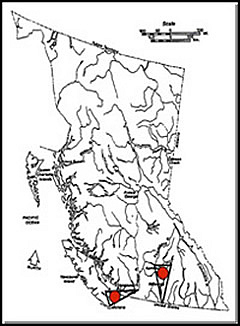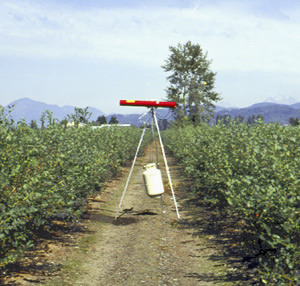Audible Bird Scare Devices in B.C.
Audible Bird Scare Devices (including propane cannons) are a non-lethal tool used by farmers to minimize bird predation on crops. These devices emit a loud noise that frightens birds away from the crop. The use of audible bird scare devices to protect crops is a common practice in blueberries, cherries and grapes.
The use of these devices has resulted in noise complaints from neighbours. A key report by the British Columbia Farm Industry Review Board (BCFIRB) is listed below and is the basis for the current regulation of propane cannons.
In the fall of 2011, the Minister of Agriculture directed the BCFIRB to report on options for provincial government, local governments and BCFIRB over time for ensuring effective and appropriate regulation of propane cannon use.
Local Government Options for Regulating Audible Bird Scare Devices
Both the 2011 BCFIRB Farm Practices and Conflict Management Report and the 2009 BCFIRB Report on the use of propane cannons point out that conflict can be avoided by the use of planning initiatives and tools as those included in the Edge Planning process as a way to improve compatibility between farm and urban land uses. Existing issues can be effectively addressed locally by an Agricultural Advisory Committee with broad representation from the local agricultural industry and refer this issue to them for their study and recommendations.
- BCFIRB Farm Practices and Conflict Management Report (PDF - 2011)
It is recommended that local governments not pursue a ban on propane cannons for their jurisdiction until they have exhausted all other available means for managing cannon conflicts in their community, including each of the recommendations pertaining to local governments in the 2009 report.
Local governments have a number of options available to manage this issue. A roadmap of possibilities in order of increasing regulation:
- Provide bylaw enforcement using the existing noise bylaw where growers are not following the Wildlife Damage Control guidelines published by the Ministry of Agriculture. (Note: local governments in the lower Fraser Valley may continue to refer complainants to the British Columbia Blueberry Council (BCBC) when the noise complaints are regarding a blueberry farm). These are discussed later in the Ministry Guidelines section.
- Incorporate the Wildlife Damage Control guidelines into their noise bylaw and provide bylaw enforcement where growers are not following the Wildlife Damage Control guidelines published by the Ministry of Agriculture. (Referral of complainants to the BC Blueberry Council is still an option.)
- Adopt a “Farm Bylaw” (see the Guide for Bylaw Development in Farming Areas) as a regulated local government under the Local Government Act with the option of including more restrictions than are contained in the Wildlife Damage Control guidelines subject to ministerial approval. Farmers are expected to follow the farm bylaw as part of land use regulation under the Farm Practices Protection (Right to Farm) Act. Regulated local governments may use edge planning tools (found in the Guide to Edge Planning) on both sides of the Urban/ALR edge to promote land use compatibility. (Referral of complainants to BC Blueberry Council is still an option.)
Local government bylaw enforcement can readily enforce elements of the ministry’s South Coast and Interior Wildlife Damage Control guidelines where there are objective measurements such as:
- Hours of use of devices
- Separation distance to a neighbouring residence
- Density of devices
- Firing frequency of devices
- Whether a Bird Management Plan exists
By having the Wildlife Damage Control guidelines written into the noise bylaw, it makes it clearer to the farmer that non-compliance is subject to bylaw enforcement. By including the criteria in a “Farm Bylaw”, the bylaw becomes part of land use regulation and must be followed as part of “normal farm practice” under the Farm Practices Protection (Right to Farm) Act.
The more subjective elements of the Wildlife Damage Control guidelines are more difficult for local government bylaw enforcement to interpret and may be more suited to be submitted to resolution through a formal complaint. The BCFIRB process can investigate and determine whether these practices are considered ‘normal farm practice’ under the FPPA. Examples of these criteria are:
- Should use devices only as outlined in the following:
- Operate cannons only when bird pressure is sufficient to justify propane cannon use
- Cannons are used in a manner to minimize both device use and bird habituation to devices
Local government bylaw enforcement can provide timely compliance tools and address repeated offences of the objective measures by providing a financial penalty for non-compliance. BCFIRB decisions can effectively address the more subjective measures by removing the “Right to Farm” defense where farmers are using the devices improperly.
Guidelines
The use of propane cannons is one of a number of actions available to protect crops in the lower mainland. It is a longstanding issue that is well studied most recently in regard to farming activities in the lower mainland. These same recommendations and actions would be helpful in other areas, as well.
In 2009, the BCFIRB issued the report Review of the Use and Regulation of Propane Cannons in the South Coastal Region, on the topic. Key findings of the report are:
- The issue of noise from propane cannons is best addressed at the local rather than provincial level
- Local governments have existing tools to regulate the use of propane cannons
- Local governments should employ the various tools available to them to solve the issue rather than moving immediately to a request to ban propane cannons in their community
To address the particular issue of the use of audible bird scare devices for crop protection the ministry has established guidelines for their use. These guidelines provide practical steps and practices which, if implemented consistently by all farmers, have shown to minimize disturbances at the farm level. In addition; land use planning at the community level is key to promoting land use compatibility especially along the urban residential/ALR edges.
The guidelines are set out in a number of farm practice factsheets describe practices which are considered proper and accepted in farming areas. The use of audible bird scare devices in various areas of the province is set out on page 3 of the following two farm practice factsheets.
- South Coastal BC Wildlife Damage Control Guidelines (PDF)
- Interior BC Wildlife Damage Control Guidelines (PDF)
Audible bird scare devices are not the only control method available to farmers. Farmers are encouraged to take an integrated approach to bird control on their farms and maximize the effectiveness of control measures by planning carefully. Netting is another option for bird control. The following factsheets will assist in making a decision on netting from a financial standpoint.
Addressing farm practice concerns
Studies on cannon use and noise issue
Contact information
Regional Agri-teams are available across the province to help provide direct assistance on matters concerning agricultural land.
Phone:
604-556-3001
1-888-221-7141
Email:
AgriServiceBC@gov.bc.ca

